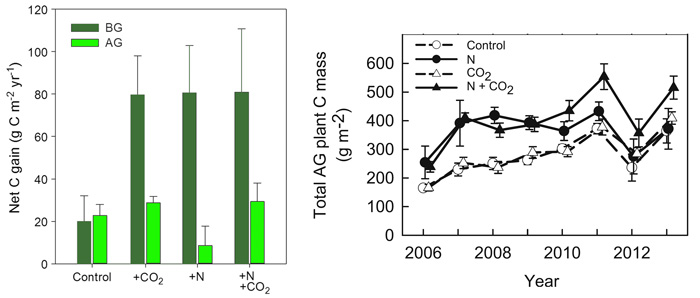| Follow @co2science |
Paper Reviewed
Pastore, M., Megonigal, J.P. and Langley, J.A. 2017. Elevated CO2 and nitrogen addition accelerate net carbon gain in a brackish marsh. Biogeochemistry 133: 73-87.
Wetlands are important ecosystems that have the potential to sequester large amounts of carbon (C) per area. However, in the words of Pastore et al. (2017), "how global changes may alter wetland contributions to future greenhouse gas fluxes is poorly understood."
In an effort to gain some knowledge in this regard, the team of three researchers conducted an eight-year experiment to estimate the average rate of ecosystem C gain in a brackish marsh located along the Rhode River at the Smithsonian Environmental Research Center in Edgewater, Maryland, USA. During the summer of 2005, 20 open-top chambers were constructed over 3.3 m2 octagonal plots and in May of 2006 the plots were exposed to one of two levels of atmospheric CO2 (ambient or ambient + 340 ppm) and one of two levels of nitrogen (N) addition (0 or 25 g N m-2 year-1). It was the hypothesis of the three scientists that elevated CO2, which was supplied only during daylight hours of the growing season, would enhance ecosystem C gain. And what did their experiment reveal?
Pastore et al. report that the "addition of either N or CO2 increased belowground C gain significantly," adding that "both factors also increased soil C density at several depths." As shown in the figure below, N and CO2 each increased the belowground C gain by fourfold, or about 60 g C m-2 year-1. In contrast, they say "there were no significant treatment effects on aboveground net C gain, but elevated CO2 tended to increase and N addition tended to decrease aboveground net C gain."
Commenting on these findings, Pastore et al. write that "C sink activity in a brackish marsh is similarly enhanced by addition of N, CO2, or both resources together, primarily due to enhanced C storage belowground." What is more, they conclude that "adding resources, either CO2 or N, will likely increase 'blue carbon' accumulation rates in tidal marshes."

Figure 1. Left panel: Mean annual net C gain in belowground plant matter and soil (BG) and aboveground plant matter (AG). Right panel: Total annual aboveground C mass in the brackish wetland from 2006 to 2012. Source: Pastore et al. (2017).




